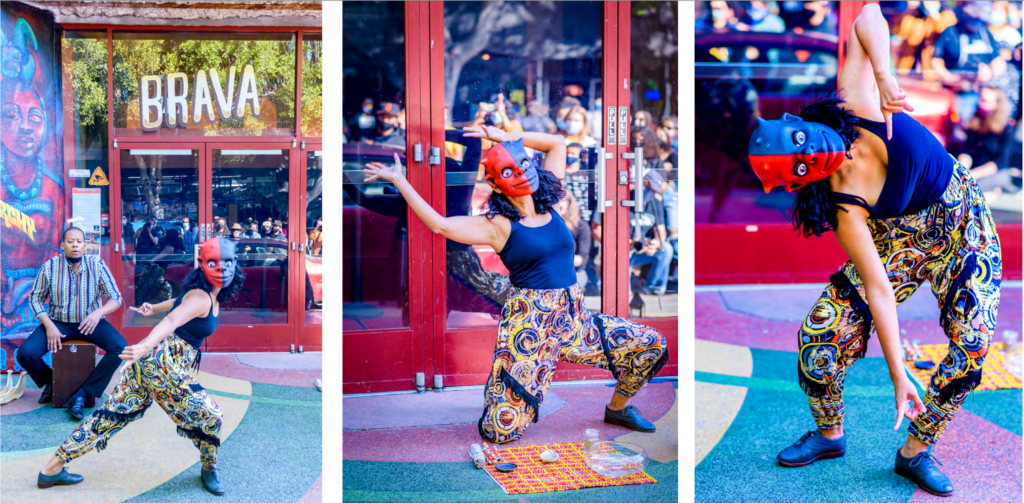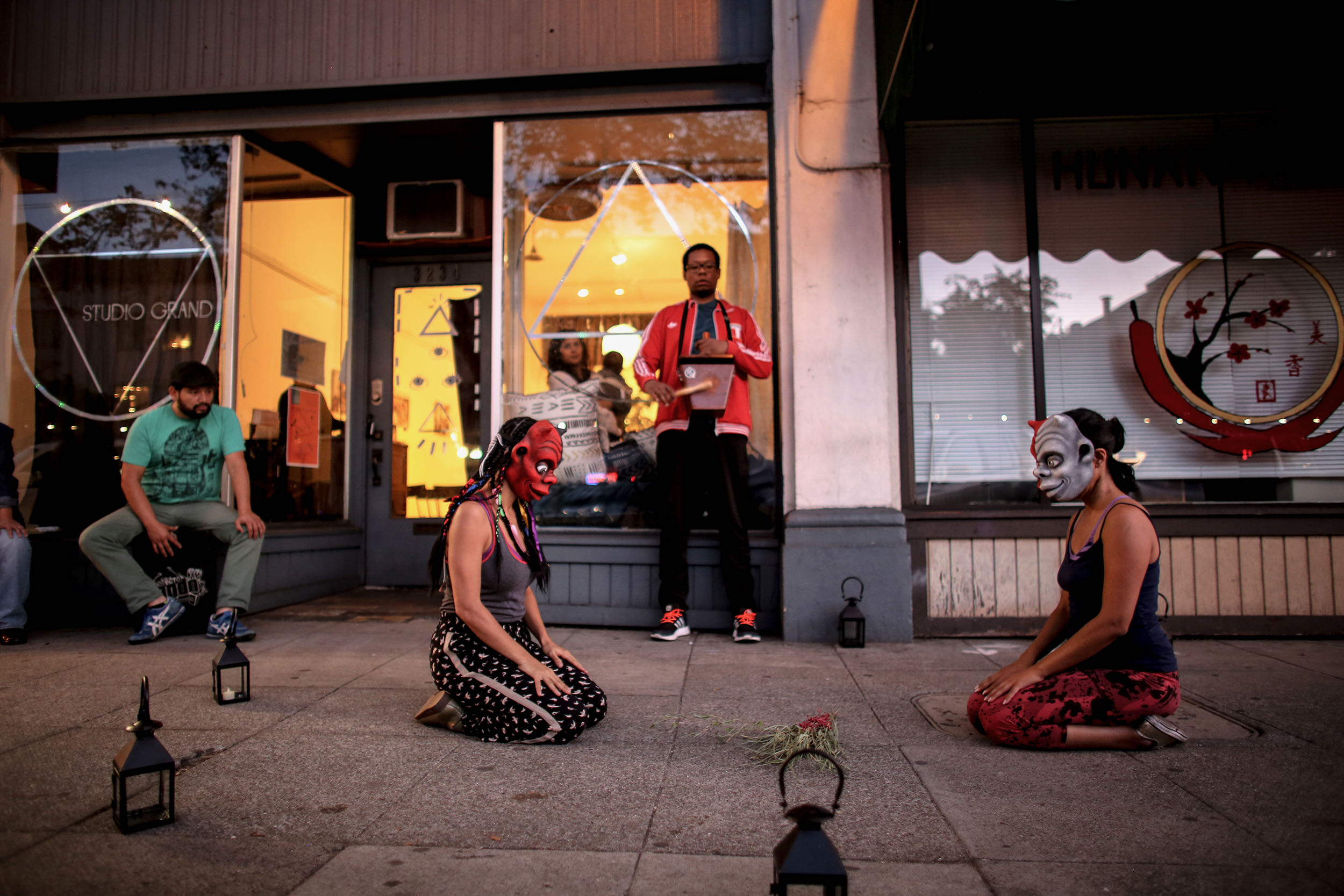Photo by Jean Melesaine
[ID: Two dancers wearing devil masks are kneeling on the sidewalk facing each other. Behind, there is a woman looking through a window holding a baby, a man of African descent wearing glasses and a red jacket holding a cajita (an instrument), and a Hispanic man sitting on a Cajon wearing a hat and a green shirt.]
“Ritmos Negros del Perú (Black Rhythms of Peru)”
By Nicomedes Santa Cruz
Dedicated to don Porfirio Vásquez A.
Translation adapted from “Black Rhythms of Peru” by Heidi Feldman
Ritmos de la esclavitud
Contra amarguras y penas.
Al compás de las cadenas
Ritmos negros del Perú.
De África llegó mi abuela
vestida con caracoles,
la trajeron lo’ españoles
en un barco carabela.
La marcaron con candela
la carimba fue su cruz.
Y en América del Sur
al golpe de sus dolores
dieron los negros tambores
ritmos de la esclavitud.
Por una moneda sola
la revendieron en Lima
y en la Hacienda ‘La Molina’
sirvió a la gente española.
Con otros negros de Angola
ganaron por sus faenas
zancudos para sus venas
para dormir duro suelo
y naíta’e consuelo
contra amarguras y penas…
En la plantación de caña
nació el triste socabón,
en el trapiche de ron
el negro cantó la zaña.
El machete y la guadaña
curtió sus manos morenas;
y los indios con sus quenas
y el negro con tamborete
cantaron su triste suerte
al compás de las cadenas.
Murieron los negros viejos
pero entre la caña seca
se escucha su zamacueca
y el panalivio muy lejos.
Y se escuchan los festejos
que cantó en su juventud.
De Cañete a Tombuctú,
De Chancay a Mozambique
llevan sus claros repiques
ritmos negros del Perú.
Rhythm of slavery
Against bitterness and sorrow.
To the beat of the chains
Black rhythms of Peru.
My grandmother came from Africa
adorned in shells,
Spaniards brought her
in a caravel ship.
They marked her with fire
the branding iron was her cross.
And in South America
to the beat of her pain
Black drums sounded
rhythms of slavery.
For a single coin
she was resold in Lima
and in the Hacienda ‘La Molina’
she served Spanish people.
With other Blacks from Angola
they earned for their labor
mosquitos for their veins
to sleep, a hard ground
and no consolation
against bitterness and sorrow…
On the sugar plantation
was born the sorrowful socabón,
at the rum press
the Black man sang the zaña.
The machete and the scythe
toughened his brown hands;
and the Indians with their quenas
and the Black man with the drum
they sang their sad fate
to the beat of the chains.
The old Blacks died
but among the dried sugar cane
one hears the sound of their zamacueca
and the panalivio far in the distance.
And one hears the festejos
that they sang in their youth.
From Cañete to Timbuktu,
from Chancay to Mozambique
their clear drum rolls carry
Black rhythms of Peru.
Names of Afro-Peruvian artists and culture bearers who have passed. “Ritmos Negros del Perú” and these names are recited during Huellas.
Porfirio Vásquez
Agusto y Elias Ascues
Nicomedes Santa Cruz
Victoria Santa Cruz
Abelardo, Vicente, Osvaldo y Jose Santos Vasquez
Ronaldo Campos
Caitro Soto
Mercedes Traslaviña
Vicky Izquierdo
Lucila Campos
Carlos Hayre
Felix Casaverde
Chocolate Argendones
Amador Ballumbrosio
Adelina Guadalupe
Eusebio Sirio Pititi
Manuela Lavalle
Chalena Vasquez
Pepe Vasquez
Manuel Vasquez “Mangüe”
Rafael Santa Cruz
Aldo Borjas
El Tati Agüero
Lalo Izquierdo
The work of Cunamacué is one of reimagining, remembering and reconstructing Afro-Peruvian dance practices. By combining Afro-Peruvian dance movements with ancestral memory and historical information, Cunamacué brings visibility to the presence and cultural contributions of African descendants in Peru. I founded Cunamacué in 2010 in Oakland, California.
Cunamacué’s latest work, Huellas (Footprints), is inspired by the ancestral dance Son de los Diablos.
Son de los Diablos is a street masquerade dance that originated during colonial times in the Catholic procession of Corpus Christi. Originally, Son de los Diablos was only a comparsa–a group of musicians that take part in carnivals and other festivities. Peruvians of African descent took this dance and made it their own by adding dance movements, and interacting with the audience in a playful manner; dancers wore devil masks to represent the disorder and sin the Catholic church was supposed to redeem.
For Cunamacué, Son de los Diablos is synonymous with resilience. African descendants were able to turn around the duress of the slave system and give life to this dance form.
***

[ID: A series of three photos showing the same dancer wearing a red and black mask, black tank top, and patterned pants. (Left) In the foreground, the dancer is in a lunge-like position facing sideways and looks toward the camera. In the background a man plays the Cajon, a jawbone on the ground next to him. There’s a mural in the back and the text “Brava” reads atop glass doors. (Middle) The dancer is kneeling behind a cloth with a bowl and other items on top. Audience members wearing face coverings are reflected in the glass door. (Right) The dancer leans sideways so their body is in a curved shape with one elbow pointing up and the other arm pointing to the ground.]
Son de los Diablos is the first-documented dance of African descendants in Peru. The dance may have given way to Afro-Peruvian instruments such as the cajita (small wooden box) and quijada de burro (donkey’s jawbone). Both instruments appear alongside dancers wearing devil masks in watercolors by an Afro-Peruvian artist named Pancho Fierro who painted everyday life in Lima during colonial times.
African descendants may have also hidden their deities behind the masks. Although there is no written documentation of this, ethnomusicologist Chalena Vasquez makes mention of it as a possibility in the documentary La voz de los sin voz.
For us, wearing masks represents a connection to the ancestral world. It helps create a space to remember how we worshiped and encountered energies or deities that existed in our cosmology before we were colonized.
“There is power as well as ancestral lineage that gets passed on when a mask is worn,” my colleague and fellow Cunamacué member Nia Womack-Freeman reminds us. “So, for me, to have the opportunity to be open to receiving that is a great blessing. I feel dancing in this way creates a connection with ancestors where they can pass their wisdom and traditions to the next generation.”
The Son de los Diablos is documented as far back as the 1800s in Fierro’s watercolors. But from the late 1950s until 1988 the Son de los Diablos dance disappeared from both popular practice and stage. In February 1988 Movimiento Negro Francisco Congo and Grupo Cultural Yuyachkani brought back the dance. A group of around 30 dancers and musicians paraded through the streets of Lima.
As a stage production, Son de los Diablos’ movements, costumes, and masks were standardized. It became a tradition for the Son de los Diablos masks to be all red. In Pancho Fierro’s watercolors we can see masks that are two colors. Perhaps the colors represented deities, perhaps they represented nations, or neighborhoods, we don’t know. In Cunamacué’s elaboration of Son de los Diablos, we also wear masks that are two colors. One side is red, the other color varies. Wearing these two-colored masks reminds us that even though the masks are separate from us, when we put them on, they allow us to embody our ancestral spirit, energy, or deity.
African religions did not survive in Peru. Because of that, in my dance creations, I often imagine a dance practice that goes hand in hand with a spiritual practice, one that was not imposed upon us.
Huellas is a collective creation between myself; Afro-Peruvian dancer, musician, and actor Pierr Padilla Vasquez; and violinist Kyla Danysh. The title of the performance, Huellas literally translates to “footprints,” as in ancestral footprints on which we walk along. Both the origins of Son de los Diablos and the wearing of the devil masks originated from a colonial Catholic perspective. Colonizers tried to impose a persona upon African descendants, but instead African descendants in Peru adopted the dance and created a cultural practice of it. Huellas is a music, dance, and theater piece that renders tribute to our individual and collective ancestors who have laid the ground for us and whose work we build upon.
Huellas will premiere November 19 and 20 at St. James Episcopal Church in Oakland. Presenting Huellas inside a church is a revindication of that arduous path our ancestors walked upon, of the imposition of the masks, and of religion itself.
This article appeared in the Fall 2022 issue of In Dance.


